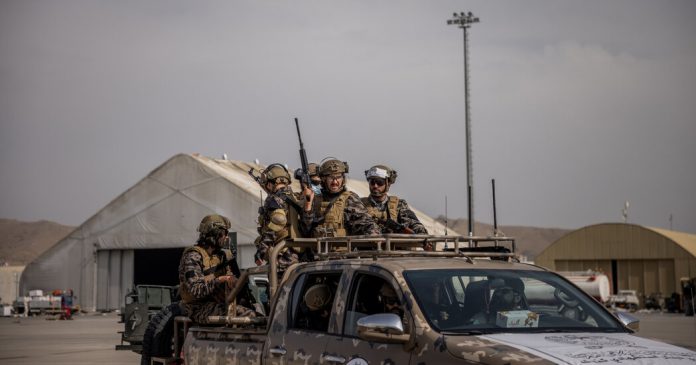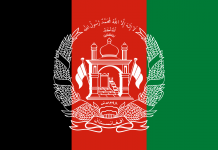This article is written by Akshita Gupta, from Symbiosis Law School, Noida. This article discusses the current situation of Afghanistan and how the Taliban is a threat to the neighboring countries of Afghanistan.
Table of Contents
Introduction
After 20 years, the Taliban militant group has reclaimed power in Afghanistan. On August 15, 2021, the Taliban took control of Afghanistan by seizing Kabul and completely taking over the country in a rapid assault that saw provinces and warlords fall without resistance. The bleak situation arose after the United States opted to pull out of Afghanistan its soldiers after two decades of service. US President, Joe Biden announced earlier this year that the US will remove its soldiers from Afghanistan for the first time since the 9/11 attacks. The US has spent over a trillion dollars in the country, according to the President, and has attained its goals.
The Taliban saw this move by the US as a chance to entirely take control of major states in Afghanistan and outrun the Afghan forces. The Taliban insurgents began killing citizens and breaking into their homes, kidnapping girls and women, raping them, and treating them inhumanely. People from all around the country flocked to airports in an attempt to flee their homes as soon as possible. Afghanistan’s turbulent climate will surely have an influence on the local economy, but it will also have an impact on international markets.
Talibans in Afghanistan
Formation of Taliban
Mullah Mohammad Omar, a Pashtun tribe member who became a mujahideen commander and helped throw the Soviets out of Afghanistan in 1989, created the Taliban in southern Afghanistan. Mullah Omar founded the organization in Kandahar in 1994 with roughly 50 supporters to combat the insecurity, corruption, and criminality that engulfed Afghanistan during the post-Soviet civil war.
As Afghans grew dissatisfied with the country’s insecurity, the Taliban rapidly conquered Kandahar and the capital, Kabul, in 1996. The Taliban quickly enforced stringent Islamic laws banning television and music, prohibiting girls from attending school, and requiring women to wear burqas from head to toe. Bin Laden was given haven by the Taliban while planning the September 11 terrorist strikes.
When the Taliban refused to hand over bin Laden as demanded by the US, American soldiers invaded Afghanistan and overthrew Mullah Omar’s administration.
While mounting an insurgent struggle to reclaim power in Afghanistan, Mullah Omar and other Taliban commanders sought refuge in Pakistan. The US and the Taliban inked a historic agreement in February 2020, outlining a 14-month timeline for the US to remove all of its forces from Afghanistan. In the meantime, discussions between the Taliban and the Afghan government to end the war have stalled.
Purpose of the Taliban’s fight
The Taliban are seeking to destabilize Kabul’s US-backed administration and reimpose their harsh interpretation of Islam across the country. Taliban commanders claim they want to build an inclusive government that is not a danger to the West, but the group has reimposed severe rule in the areas it controls.
Leader of Taliban
Mullah Omar died in 2013, although his death was not announced by the Taliban until 2015.
Mullah Omar’s successor, Mullah Akhtar Mohammad Mansour, was murdered by a US drone strike in Pakistan in 2016. Mawlawi Haibatullah Akhundzada, a Pashtun from Kandahar who formerly led the group’s Islamic courts, has led the organization since then. The Taliban’s decisions are guided by a council of leaders stationed in Pakistan, known as the Quetta Shura.
Taliban’s sources of income
The Taliban rely heavily on the illegal drug trade in Afghanistan for funding. Taxes are levied on poppy growers and heroin makers in the areas of Afghanistan that the organization controls. In addition, the Taliban levy fees on businesses and exploit illicit mining throughout the country. Supporters in Pakistan and the Gulf provide money to the organization regularly. According to analysts from the North Atlantic Treaty Organization, the Taliban rise by $1.6 billion per year.
Recognition of Taliban by neighboring countries of Afghanistan
With the Taliban regaining power in Afghanistan, the next big ambition for the neighbors is for them to concede the organization. It is the polishing of old friendships for some, while it is either the warming up of relationships or the reluctant acceptance of the new reality for others. Pakistan, Saudi Arabia, and the United Arab Emirates were the only states to acknowledge the Taliban when they first took control in 1996. Apart from that, no other government had acknowledged the militants’ ability to successfully control the country. However, this time they are unwillingly attempting to find ways to engage with the group in order to avoid future significant clashes.
In light of recent negotiations, the EU has declared unequivocally that there is no rush to recognize them. Individual governments in France and Germany, on the other hand, are hardly recognizable as states, and it is not even relevant to them at the moment. The Prime Minister of the United Kingdom’s ‘take your time’ attitude obviously encourages utmost caution before recognizing the violent group. Surprisingly, the two foes of the US, Russia and China, are spearheading the charge to make overtures to the Taliban.
Russian Prime Minister Vladimir Putin said that the Taliban movement currently controls nearly the entire territory of the country, including its capital. These are facts and they must act in accordance with them, not allowing the Afghan state to disintegrate. The Chinese government, on the other hand, sees no other option to protect the interests of Chinese Muslims and has promised not to interfere in Afghanistan’s domestic affairs.
In the case of the United States and India, the issue appears to be much more serious, and the steps have been diplomatic. The US troop withdrawal has raised many questions, to which Biden’s reasons for legitimacy validation and respect for human rights have been stated. However, for India, the security of the concerned Indian nationals living in Afghanistan, as well as the fear of an expected re-alliance between the Taliban and pro-Pakistani militants, are of great importance at the moment. Eventually, what will happen will happen, but for now, the countries are busy evacuating their people from Afghanistan and figuring out how to deal with the Taliban’s current instability in the most diplomatic way possible.
US Army’s withdrawal from Afghanistan
On the 8th of July 2021, Joe Biden stated unequivocally that:
- The country must meet its obligations under the February 2020 agreement made by the erstwhile Trump administration.
- The country’s twin objectives of bringing justice to Osama Bin Laden and preventing Afghanistan from becoming a base for terror attacks on the US and its allies have been met.
- The US “did not go to Afghanistan to construct a nation”
- Afghans must band together and do what “they want and deserve.”
- Afghanistan’s present establishment has received and will continue to get the necessary tools, training, and equipment.
- Visa regulations would be modified to make it easier for Afghans who collaborated with the US to enter the country, and essential facilities would be made available to them.
US peace deal
Background
The United States proceeded to Afghanistan in October 2001, just weeks after the 9/11 terrorist attacks, to combat terrorists (Al-Qaeda) and rebuild the country with stability. The longest war in history was the 19-year conflict between the United States and Afghanistan. The Afghan war was estimated to have cost $2 trillion and resulted in the deaths of over 3500 American and coalition personnel.
Thousands of people have died in Afghanistan, both civilians and soldiers. After all of this, the Taliban was the most powerful force since the United States was founded. The hinterlands were mostly in charge of half of the country. For a long time, the war was stuck in a stalemate, and despite the efforts of both US Presidents, Barack Obama and Donald Trump, to send more troops, the conflict remained stalled. The US, which only wanted to leave Afghanistan, had no other option.
Features of the peace deal
Withdrawal of the US troops
The US drew 8600 troops from a total of 14000 troops in 235 days. Within 14 months, all of the troops had been demobilized. With the recognition of the new agreement, the partners and alliance in the Afghan security operation known as “Resolute” reduced their military presence in the country. A total of 17000 troops from 39 countries were part of the resolution.
Taliban commitment
They will not allow any member, individual, or group, including al-Qaeda, to utilize Afghan soil if their security is threatened by the US and its allies, who have excluded India.
Exchange of prisoners
The US committed to begin working immediately with all essential parties on a plan for the release of 5000 Taliban and 1000 government prisoners by March 10, 2020, with the assurance of measuring the structures.
Intra-Afghan peace talks
Throughout the negotiations, the Taliban was confronted with the Afghan government’s rejection of US direct talks, and they decided to begin Intra-Afghan negotiations on March 10, 2020. The agreement was made public and did not include any provisions for the Taliban, such as reducing attacks on government forces and implementing the pact’s annexes, which detailed the classified negotiations. The de facto fifth provision in the current statement revealed the spokesman for US military command in Afghanistan (Military Times, 6th May 2020).
Violence reduction
The sides were formed by verbal commitment, which reduced violence by 80%. The report took more than ten weeks to complete and was judged on how well the five fundamental pillars of the US-Taliban peace agreement were implemented. The US and the Taliban kept their reciprocal obligations to each other, including the intra-Afghan prisoner swap, peace negotiations, and a reduction in bloodshed that had been hampered by delays and setbacks.
What is at stake as U.S. soldiers leave Afghanistan?
The United States has spent trillions of dollars trying to stabilize Afghanistan and prevent it from becoming a new haven for terrorist organizations such as Al Qaeda and the Islamic State who may plot strikes against the United States and its allies. A fast collapse of the US-backed Afghan government would be a moral and political setback for western dominance and interests in the region, where Pakistan, China, India, and Russia are all vying for strategic advantages. While the Taliban has committed to keeping extremist groups out of Afghanistan, western diplomats are concerned that the group would not follow through on its promises.
Taliban is a threat to Afghanistan’s neighboring countries
It is not only India that is concerned about the return of the Taliban but also other Asian nations are concerned since the Taliban is considered a security headache to them. Irrespective of this fact, Pakistan and China are looking for a way to gain an advantage in Afghanistan, Asia’s strategic heartland.
India’s concerns
Since April 2020, when the Taliban’s return was in its early stages and COVID-19 had surfaced as a threat, the consulate has been temporarily closed three times. India closed its consulates in Herat and Jalalabad at the time. India is concerned about the safety of approximately 3,000 Indian nationals and diplomats now stationed in Afghanistan.
For the record, India, like the rest of the world, has backed Afghan President Ashraf Ghani in his fight against terrorism. After the country was decimated by the previous period of civil conflict between the Taliban and government-backed troops, India became a partner in Afghanistan’s reconstruction.
Since 2001, when American soldiers drove the Taliban out of Kabul, India has contributed an estimated $3 billion in reconstruction. There is no official communication line between India and the Taliban. During the first Taliban rule in Afghanistan in the 1990s, it had proven costly. However, India is not the only country concerned about the Taliban’s return to Afghanistan. The development is believed to be the main topic of discussion at the Shanghai Cooperation Organisation‘s two-day meeting of foreign ministers in Dushanbe, Tajikistan’s capital, where nearly 1,000 Afghan soldiers fled for their life after being surrounded by the Taliban.
Pakistan’s worry
Pakistan, which is thought to be heavily involved in the Taliban’s operations in Afghanistan through the Pakistan Army’s Inter-Service Intelligence (ISI), has its concerns with the Taliban’s rise. Pakistan shares a long border with Afghanistan, and the Taliban’s growth has exacerbated anxiety and insecurity among non-Pashtun ethnic groups, particularly along the border. On the Pakistani side of the border, it could lead to inter-tribal militia confrontations.
When the Taliban took control of Afghanistan the last time, it also targeted border districts in Pakistan’s Balochistan and Khyber Pakhtunkhwa provinces.
According to reports from Pakistan, residents, particularly in Balochistan, are concerned that they will once again be deprived of their agricultural lands and forced to relocate. Pakistan is dealing with a rebellion in Balochistan as a result of the Pakistan Army and other government agencies allegedly persecuting the Baloch ethnic population. According to recent reports, Pakistani Prime Minister Imran Khan is reaching out to Baloch leaders as Taliban pressure intensifies on Pakistan’s borders following the United States’ withdrawal from Afghanistan. Then there is the Taliban in Pakistan, which is distinct from the Taliban in Afghanistan. The Pakistan Taliban aim to impose a stricter Sharia law on Pakistan than what is currently in place.
China’s intention
Through its restive Xinjiang province, China shares a tiny border with Afghanistan. According to the report, the Taliban has a soft spot for Uighur Muslim organizations fighting China’s communist authority. China is concerned that if Afghanistan is settled, the Taliban will aid the East Turkestan Islamic Movement (ETIM). The ETIM is a separatist group in China’s Xinjiang region, which is home to Uighur Muslims. Xinjiang shares borders with the Badakhshan region in Afghanistan, which the Taliban recently took from Afghan government forces.
The UN classified the East Turkestan Islamic Movement in Xinjiang to be one of the deadliest terror organizations in 2006 and outlawed it. The restriction was only abolished by Donald Trump’s administration in 2020.
China is building a route across Afghanistan’s Badakhshan province to its own Xinjiang Uighur Autonomous Region through the famed Wakhan Corridor. The Wakhan Corridor, once completed, will provide direct access to Chinese territories in Xinjiang.
Concerns of countries from Tajikistan to Russia
Afghanistan shares borders with Iran, Pakistan, Tajikistan, Turkmenistan, Uzbekistan, China, and India (however Pakistan has occupied sections of India’s Ladakh territory since 1947-48). Except for Iran and Turkmenistan, all of these countries are members of the Shanghai Cooperation Organization, which met in Dushanbe. Russia, Kirghizstan, and Kazakhstan are also founding members of the SCO.
Tajikistan and Uzbekistan are concerned that the Taliban’s resurgence may result in ethnic migration into their territories. In the 1990s, the Taliban formed its first rule, declaring then-Afghan President Burhanuddin Rabbani, a Tajik, to be anti-Pashtun.
Kazakhstan, Kyrgyzstan, and Turkmenistan are all concerned about a rise in Islamic radicalism. Several Islamic extremist groups with ties to Afghan organizations are functioning in various nations.
Russia has a long history in Afghanistan, and it is now in discussions with the Taliban. Any spillover impact from the Taliban’s control of Afghanistan throughout the region jeopardizes the country’s strategic interests, particularly in Uzbekistan and Tajikistan.
The economic impact on Afghanistan
It is self-evident that after the Taliban took control of Afghanistan, the country’s economy would have taken a step backwards. With so many people already leaving the country and others wanting to leave, the economy is projected to continue to deteriorate, putting the country’s economy in even more jeopardy. According to the Asian Development Bank, more than 47% of the country’s population was already impoverished in 2020, and 34.3 percent of those with jobs live on less than $1.90 a day. The reasons for the same are most households are reliant on the low-productivity agriculture sector for income, due to security concerns, corruption, and political instability, which have all impeded private-sector development. Unemployment was at 11.7 percent in 2020, pre-Taliban control when people began fleeing the country and some women were sacked from their jobs. The economy currently appears to be more vulnerable because future financial support is unknown.
Due to the government’s instability, the International Monetary Fund (IMF) has announced that it will halt its financial assistance to Afghanistan. Afghanistan already relies significantly on international help, which will now be cut off as a result of the terrorist group’s takeover.
The export of valuable minerals from Afghanistan, which had been a reliable source of revenue, would come to a standstill, severely affecting the economy.
Recent Taliban attack
In Afghanistan, two ISIS-K bombs exploded outside the Kabul airport, killing at least 100 Afghans and 13 American servicemen. There has been an increasing mood of total terror among citizens as the deadline for evacuating nationals from the country approaches. Several civilians, including children, have been murdered in recent US drone and missile assaults. Afghan refugees and students in India have staged many protests, pleading with the government to assist them to secure the safety of their stranded families and relatives in Afghanistan.
In addition, there have been some rallies by women activists in Afghanistan and a few other nations for the protection of their democratic rights, but the governments have not provided enough support as of now. The suffering of 150 stranded Indians at Kabul’s Hamid Karzai airport has been highlighted in recent updates, with claims that they are not being permitted to enter and that no authority is available to assist them.
Furthermore, according to the UN Food Chief, if the UN agency fails to raise $200 million by September, Afghanistan will face yet another disaster, as the country already faces economic collapse as a result of foreign countries and institutions withholding support and monetary reserves after Islamist Taliban militants took control of Kabul on August 15.
Refugee crisis
There has been an increase in population pressure in several countries as a result of the influx of Afghan refugees. Afghan migrants are among the most resilient refugee populations on the planet. People have been uprooted from their homes during the last four decades, either never to see them again or, even if they do, to have their lives swept away by a new outbreak of war and bloodshed, forcing them to relocate elsewhere in the country or become refugees once more. It appears to go on forever.
The UN’s Refugee Agency has begun to pressurize various nations with the problem of the rising population once again, predicting a huge migration of Afghans. The United Nations has warned that up to 500,000 Afghans may flee the country by the end of the year, urging neighboring countries to keep their borders open. The new disaster adds to the 2.2 million Afghan refugees currently in neighboring countries and the 3.5 million internally displaced Afghans.
Several nations, including Canada, Australia, the United Kingdom, India, and the United States, have stepped up their evacuation efforts and are now taking refugees. However, unlike the previous migration crisis in 2015/16, the EU may not accept as many refugees as it did previously (over a million), owing to political considerations and/or a greater capacity to deter and repatriate illegal migrants. Since the last crisis, the EU has beefed up its border and established the Frontex coast-guarding agency. Many EU countries, including Germany, Austria, and Greece, have been working hard to avoid a repeat of the huge migration in 2015/16, partly due to worries of voter reaction.
According to early 2021 data from the UN Refugee Agency, Pakistan already has 1.4 million Afghan refugees, while Iran has roughly a million. The number of undocumented Afghans is thought to be much higher in both countries. As a result, Afghan migrants may find it difficult to seek asylum in the EU. Although countries continue to provide humanitarian aid to civilians, the future uncertainty for refugees appears to be unfavorable, as an increase in the number of unregistered and illegal immigrants has led countries to avoid exodus from Afghanistan in order to maintain their country’s population, particularly during the coronavirus pandemic.
What does Afghanistan’s future hold?
The current situation in Afghanistan does not seem to come to an end in the near future. Afghanistan’s aid has already been halted by the International Monetary Fund (IMF). Few countries refuse to recognize the Taliban as a government, and it will continue to be viewed as a terrorist organization. As many have pointed out, the US and its coalition allies have a moral obligation. There is a crisis right now and whatever happens, next will be inexorably related to decades of bloodshed and interference.
The Taliban’s rules, particularly those targeting women, do not bode well for the future of the country. Women who are being targeted by the Taliban must be removed immediately. Due to the continuous violence, drought, and the Covid pandemic, millions of Afghans are on the verge of starvation, according to the World Food Programme (WFP), which has released a statement urging political authorities to take necessary actions as soon as possible.
Analysis of the current situation
With the Taliban’s abrupt takeover of Afghanistan on August 15th, 2021 (after two decades), the advent of crisis after crisis seemed to have only just begun. Knowing that the geopolitical realities of the Afghan state have been fundamentally shifting over the last few months and days, the reactions of many states across the world are both startling and not surprising. The ignominious withdrawal of US soldiers from Afghanistan has ushered in a period of predicted but unknown turbulence for not just Afghanistan but also India, China, Pakistan, the Middle East, Central Asia, Turkey, Qatar, and the United States.
Furthermore, the huge exodus of civilians from the state will undoubtedly alter the global and regional power balance. Other than Pakistan, Russia, and the United Arab Emirates, no government is in a hurry to acknowledge the extremist group’s dominance and ability to successfully control the country. Currently, Afghanistan, particularly Kabul, is in a state of panic as a result of many bombings and rocket strikes carried out by terrorist groups, notably ISIS-K, and US forces, murdering hundreds of vulnerable civilians (including children) through no fault of their own.
This acquisition will likely have a large-scale impact on Afghanistan’s economy as well as other economies throughout the world if it hasn’t already. When it comes to India, the imminent political changes in Afghanistan will cost the country billions of dollars, hurting bilateral trade and large investments in the country. Other nations, on the other hand, will undoubtedly face increased pressure from increased Afghan refugees, resulting in a new crisis of mass departure from Afghanistan and a detrimental impact on their economies. Furthermore, the current state of events in Afghanistan is leading to another humanitarian disaster, with the World Food Programme (WFP) warning of impending hunger for the country’s population. The current situation in Afghanistan will not be stable until the government is formed which works for the betterment of the population.
Conclusion
The Taliban takeover has lulled many activists into a deep slumber, fearful of a potential danger to their democratic rights, particularly women’s security, and, more importantly, of the state becoming a Jihadi Harvard, Columbia, and Oxford, as articulated by Afghanistan’s best voice. At this moment, India and other countries are recommended to avoid becoming each other’s rivals and instead take a united stance to avoid future disputes, particularly because every country is combating the coronavirus pandemic. Overall, it will be interesting to see what happens in the next few days as the Taliban consolidates its power across the country.
References
- https://www.washingtonpost.com/world/2021/08/20/afghanistan-taliban-international-recognition-aid/
- https://indianexpress.com/article/explained/who-are-the-taliban-afghanistan-history-ideology-7456032/
- https://www.bbc.com/news/world-asia-58283177
- Bilateral trade with Afghanistan to be hit due to uncertainty: Industry | Business Standard News (business-standard.com)
- https://finance.yahoo.com/news/afghanistan-fall-possible-impact-global-174112068.html
- https://www.orfonline.org/expert-speak/the-realignment-of-geopolitics-after-the-taliban-takeover-and-what-it-means-for-india/
- https://www.washingtonpost.com/world/2021/08/20/afghanistan-internally-displaced-crisis/
- https://www.wsj.com/articles/taliban-afghanistan-who-11628629642
- https://timesofindia.indiatimes.com/blogs/beyond-the-fact/intriguing-us-withdrawal-from-afghanistan-part-i/
- https://www.indiatoday.in/news-analysis/story/return-of-taliban-is-not-a-headache-for-india-only-heres-why-1827946-2021-07-14
LawSikho has created a telegram group for exchanging legal knowledge, referrals, and various opportunities. You can click on this link and join:
 Serato DJ Crack 2025Serato DJ PRO Crack
Serato DJ Crack 2025Serato DJ PRO Crack











 Allow notifications
Allow notifications



